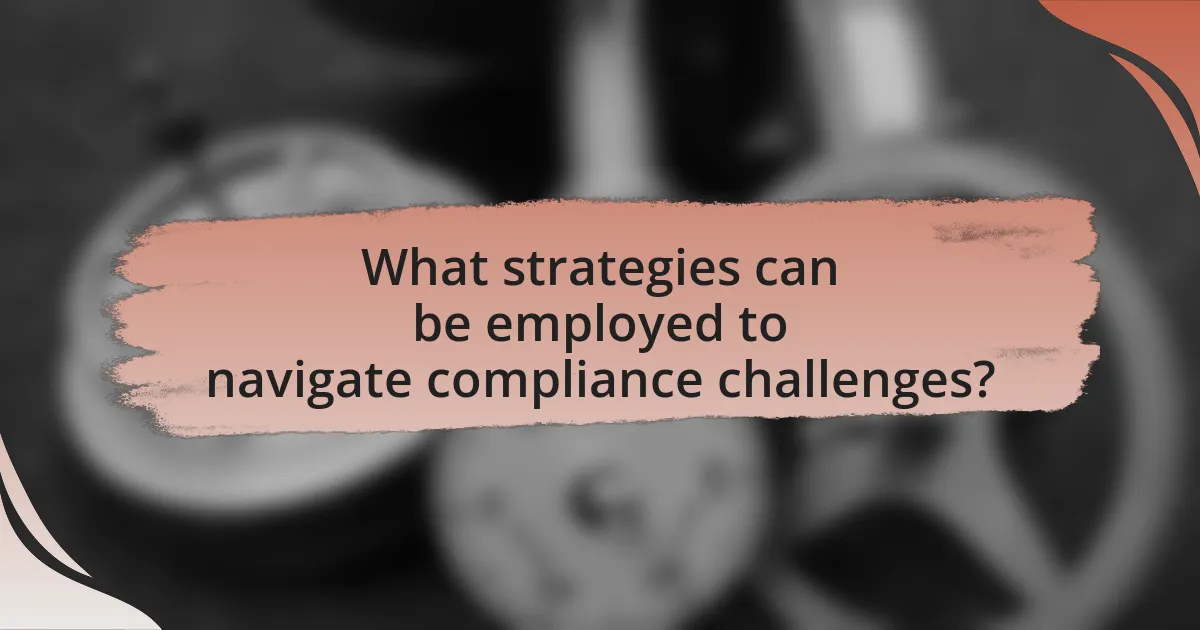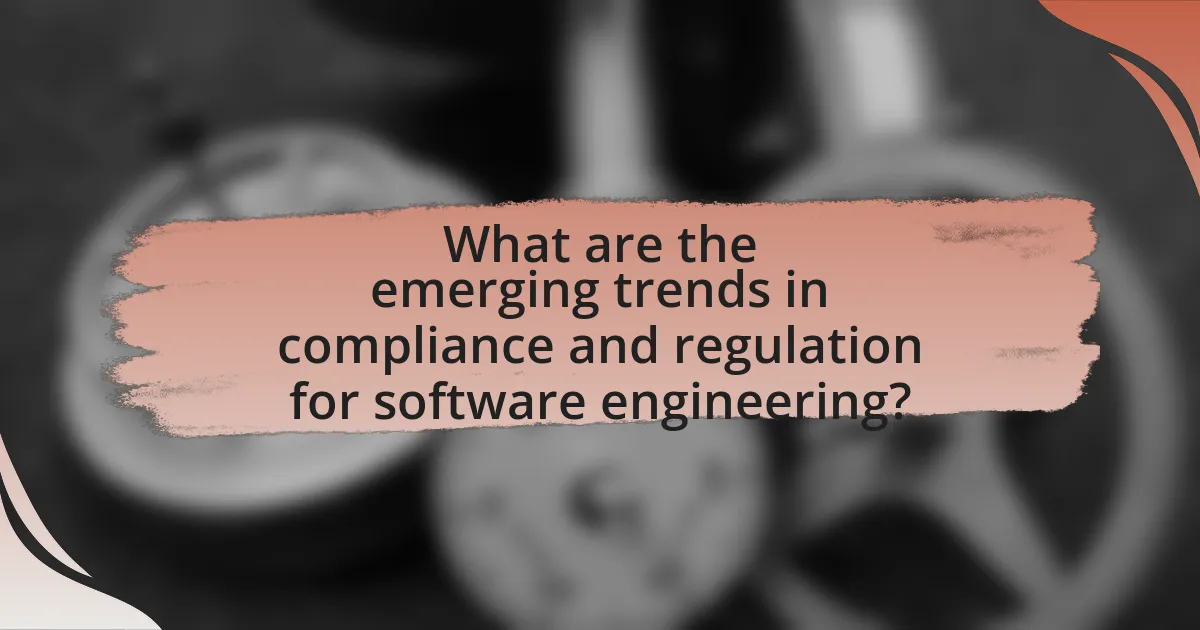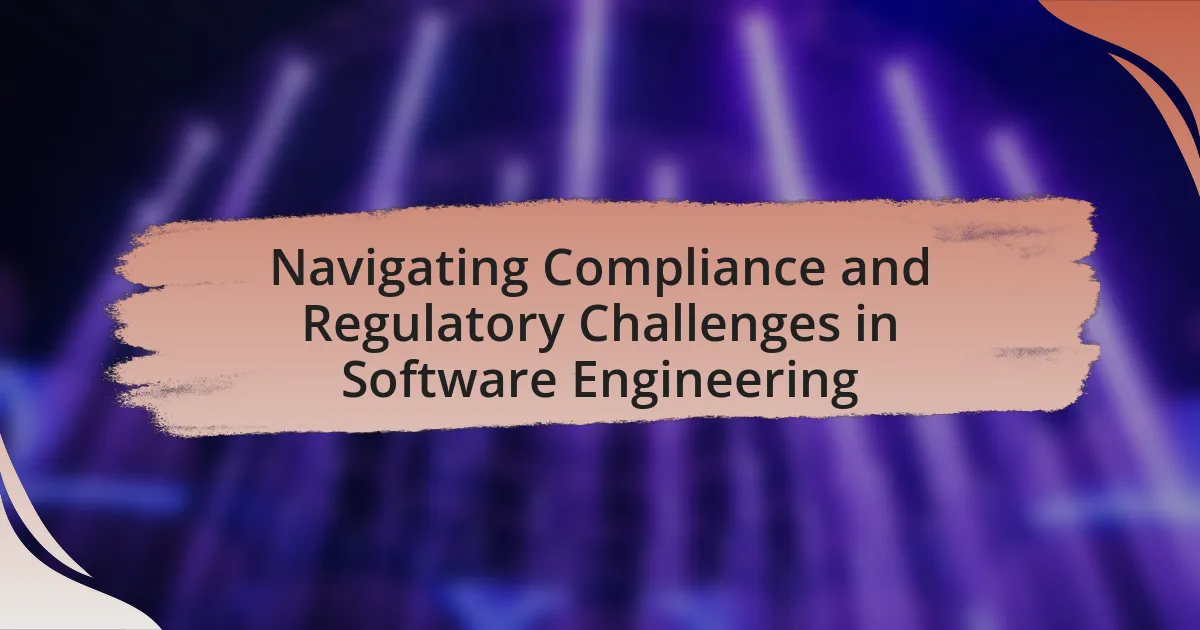The article focuses on the compliance and regulatory challenges faced in software engineering, highlighting critical areas such as data privacy, security standards, and intellectual property rights. It examines the impact of regulations like the General Data Protection Regulation (GDPR) and the Health Insurance Portability and Accountability Act (HIPAA) on software development processes, emphasizing the necessity for engineers to stay informed about evolving regulations. The discussion includes strategies for navigating compliance challenges, the role of technology in enhancing compliance practices, and best practices for maintaining compliance documentation. Additionally, it addresses the potential consequences of non-compliance and the importance of a structured approach to ensure adherence to legal and industry standards.

What are the key compliance and regulatory challenges in software engineering?
Key compliance and regulatory challenges in software engineering include data privacy, security standards, and intellectual property rights. Data privacy regulations, such as the General Data Protection Regulation (GDPR), impose strict requirements on how personal data is collected, stored, and processed, necessitating software engineers to implement robust data protection measures. Security standards, like the Payment Card Industry Data Security Standard (PCI DSS), require adherence to specific security protocols to protect sensitive information, which can complicate software development processes. Additionally, intellectual property rights present challenges in ensuring that software does not infringe on existing patents or copyrights, requiring thorough legal assessments during development. These challenges necessitate ongoing education and adaptation to evolving regulations, impacting project timelines and resource allocation.
How do regulations impact software development processes?
Regulations significantly impact software development processes by imposing requirements that developers must adhere to throughout the lifecycle of software creation. These requirements can include data protection laws, industry standards, and security protocols, which dictate how software is designed, tested, and maintained. For instance, the General Data Protection Regulation (GDPR) mandates that software handling personal data must incorporate privacy by design, influencing the architecture and functionality of applications. Compliance with such regulations often necessitates additional documentation, testing, and validation phases, which can extend development timelines and increase costs. Furthermore, failure to comply with regulations can result in legal penalties and reputational damage, compelling organizations to prioritize regulatory adherence in their development strategies.
What specific regulations must software engineers be aware of?
Software engineers must be aware of regulations such as the General Data Protection Regulation (GDPR), the Health Insurance Portability and Accountability Act (HIPAA), and the Federal Information Security Management Act (FISMA). GDPR mandates strict data protection and privacy for individuals within the European Union, requiring software engineers to implement robust data handling practices. HIPAA governs the protection of health information in the United States, necessitating compliance in software that handles medical data. FISMA establishes a framework for securing federal information systems, compelling software engineers working with government data to adhere to specific security standards. These regulations are critical for ensuring legal compliance and protecting user data in software development.
How do these regulations vary across different regions?
Regulations in software engineering vary significantly across different regions due to local laws, cultural norms, and industry standards. For instance, the European Union enforces the General Data Protection Regulation (GDPR), which mandates strict data privacy and protection measures, while the United States has a more fragmented approach with regulations like the California Consumer Privacy Act (CCPA) that apply only at the state level. Additionally, countries in Asia may have their own unique regulations, such as China’s Cybersecurity Law, which imposes stringent requirements on data localization and security. These regional differences reflect varying priorities in consumer protection, data security, and innovation, impacting how software engineering practices are implemented globally.
Why is compliance important in software engineering?
Compliance is important in software engineering because it ensures that software products meet legal, regulatory, and industry standards, thereby reducing risks associated with security breaches and legal penalties. Adhering to compliance frameworks, such as GDPR or HIPAA, protects user data and fosters trust among stakeholders. For instance, non-compliance can lead to significant fines; the European Union imposed over €1.5 billion in fines for GDPR violations in 2020 alone. Thus, compliance not only safeguards organizations from legal repercussions but also enhances their reputation and operational integrity.
What are the potential consequences of non-compliance?
Non-compliance can lead to significant legal and financial repercussions for organizations. Companies may face hefty fines, which can range from thousands to millions of dollars, depending on the severity of the violation and the regulatory framework involved. For instance, the General Data Protection Regulation (GDPR) imposes fines up to 4% of annual global turnover or €20 million, whichever is higher, for non-compliance. Additionally, non-compliance can result in reputational damage, loss of customer trust, and potential litigation costs, which can further strain financial resources and disrupt business operations.
How does compliance enhance software quality and security?
Compliance enhances software quality and security by establishing standardized practices and frameworks that guide development processes. These standards, such as ISO 9001 for quality management and ISO/IEC 27001 for information security management, ensure that software is developed with consistent quality controls and security measures. For instance, adherence to these compliance standards can lead to reduced vulnerabilities, as they require regular security assessments and risk management practices. Furthermore, organizations that comply with regulations like GDPR or HIPAA are mandated to implement data protection measures, which directly contribute to the integrity and confidentiality of software systems. This structured approach not only mitigates risks but also fosters trust among users and stakeholders, ultimately leading to higher software quality and enhanced security.

What strategies can be employed to navigate compliance challenges?
To navigate compliance challenges, organizations can implement a combination of proactive risk assessment, continuous training, and the use of compliance management software. Proactive risk assessment involves identifying potential compliance risks early in the software development lifecycle, allowing teams to address issues before they escalate. Continuous training ensures that all employees are aware of current regulations and best practices, which is crucial in a rapidly changing regulatory environment. The use of compliance management software streamlines the tracking of compliance requirements and automates reporting processes, reducing the likelihood of human error. According to a study by the Compliance, Governance and Oversight Council, organizations that adopt these strategies experience a 30% reduction in compliance-related incidents.
How can software engineers stay updated on regulatory changes?
Software engineers can stay updated on regulatory changes by subscribing to industry newsletters, attending relevant conferences, and participating in professional organizations. These methods provide timely information and insights on new regulations affecting software development. For instance, organizations like the IEEE and ACM often share updates on compliance standards and best practices. Additionally, following regulatory bodies’ websites, such as the Federal Trade Commission or the General Data Protection Regulation portal, ensures access to official announcements and guidelines. Engaging in online forums and communities also facilitates discussions on regulatory changes, allowing engineers to share knowledge and experiences.
What resources are available for tracking compliance updates?
Resources available for tracking compliance updates include regulatory agency websites, compliance management software, industry newsletters, and professional associations. Regulatory agency websites, such as the U.S. Securities and Exchange Commission or the European Data Protection Board, provide official updates on compliance requirements. Compliance management software, like LogicGate or ComplyAdvantage, offers tools for monitoring changes in regulations and managing compliance processes. Industry newsletters, such as those from the Compliance Week or the Society of Corporate Compliance and Ethics, deliver timely information on compliance developments. Professional associations, including the International Compliance Association, often provide resources, training, and updates relevant to compliance in specific sectors.
How can organizations implement a compliance training program?
Organizations can implement a compliance training program by first assessing their specific regulatory requirements and identifying the relevant compliance topics for their industry. This assessment allows organizations to tailor the training content to address the unique compliance challenges they face, such as data protection laws or industry-specific regulations.
Next, organizations should develop or source training materials that are engaging and informative, ensuring that they cover the identified compliance topics comprehensively. Incorporating real-world scenarios and case studies can enhance understanding and retention of the material.
Following the development of training materials, organizations must schedule and deliver the training sessions, utilizing various formats such as in-person workshops, online courses, or blended learning approaches to accommodate different learning preferences.
Finally, organizations should establish a system for tracking participation and assessing the effectiveness of the training through quizzes, feedback surveys, and compliance audits. This ongoing evaluation helps ensure that the training remains relevant and effective in promoting compliance within the organization.
What role does documentation play in compliance?
Documentation serves as a critical component in compliance by providing a clear record of processes, policies, and procedures that organizations must follow to meet regulatory requirements. This record ensures that all actions taken by the organization can be traced and verified, which is essential for demonstrating adherence to laws and standards. For instance, regulatory bodies often require documentation to validate compliance with data protection laws, such as the General Data Protection Regulation (GDPR), which mandates that organizations maintain records of processing activities. By maintaining thorough documentation, organizations can effectively mitigate risks, facilitate audits, and ensure accountability, thereby reinforcing their commitment to compliance.
How should software documentation be structured for compliance purposes?
Software documentation for compliance purposes should be structured to include clear sections on purpose, scope, definitions, procedures, and records management. This structure ensures that all necessary information is easily accessible and meets regulatory requirements.
The purpose section outlines the objectives of the documentation, while the scope defines the boundaries and applicability of the software. Definitions provide clarity on terminology used throughout the documentation. Procedures detail the steps necessary to comply with regulations, including roles and responsibilities. Finally, records management describes how documentation will be maintained, reviewed, and updated to ensure ongoing compliance.
This structured approach aligns with standards such as ISO 9001, which emphasizes the importance of documented information in maintaining quality management systems, thereby reinforcing the validity of this documentation strategy.
What are the best practices for maintaining compliance documentation?
The best practices for maintaining compliance documentation include establishing a clear documentation framework, regularly updating documents, ensuring accessibility, and conducting periodic audits. A clear framework defines the structure and content required for compliance documentation, which helps in maintaining consistency and clarity. Regular updates are essential to reflect changes in regulations or organizational processes, ensuring that the documentation remains relevant and accurate. Accessibility allows all stakeholders to easily retrieve and understand the documentation, promoting adherence to compliance standards. Periodic audits verify that the documentation meets regulatory requirements and identifies areas for improvement, thereby enhancing overall compliance efforts. These practices are supported by regulatory guidelines, such as ISO 9001, which emphasizes the importance of documented information in maintaining quality management systems.

What are the emerging trends in compliance and regulation for software engineering?
Emerging trends in compliance and regulation for software engineering include increased focus on data privacy, the adoption of DevSecOps practices, and the implementation of AI governance frameworks. Data privacy regulations, such as the General Data Protection Regulation (GDPR) and the California Consumer Privacy Act (CCPA), are driving software engineers to prioritize user data protection and transparency in their applications. DevSecOps integrates security practices into the software development lifecycle, ensuring compliance is maintained throughout the development process. Additionally, as artificial intelligence becomes more prevalent, organizations are establishing AI governance frameworks to address ethical considerations and regulatory compliance, ensuring responsible AI usage. These trends reflect a shift towards proactive compliance strategies in the software engineering field.
How is technology influencing compliance practices?
Technology is significantly influencing compliance practices by automating processes, enhancing data accuracy, and improving monitoring capabilities. Automation tools streamline compliance workflows, reducing human error and increasing efficiency; for instance, regulatory technology (RegTech) solutions can automatically track changes in regulations and ensure that organizations remain compliant. Enhanced data accuracy is achieved through advanced analytics and machine learning, which help identify compliance risks in real-time. Furthermore, technology enables continuous monitoring of compliance activities, allowing organizations to respond swiftly to potential violations. According to a report by Deloitte, 60% of organizations using technology for compliance reported improved compliance outcomes, demonstrating the effectiveness of these technological advancements in maintaining regulatory standards.
What tools are available to assist with compliance management?
Compliance management tools include software solutions such as GRC (Governance, Risk, and Compliance) platforms, compliance management systems, and audit management tools. These tools help organizations streamline compliance processes, manage regulatory requirements, and ensure adherence to industry standards. For instance, platforms like MetricStream and RSA Archer provide comprehensive frameworks for tracking compliance activities and managing risks effectively. Additionally, tools like LogicGate and ComplyAdvantage offer automation features that enhance efficiency in compliance workflows. These solutions are validated by their widespread adoption across various industries, demonstrating their effectiveness in managing compliance challenges.
How can automation improve compliance processes?
Automation can significantly improve compliance processes by enhancing accuracy, efficiency, and consistency in regulatory adherence. Automated systems reduce human error, which is a common issue in manual compliance tasks; for instance, a study by the International Journal of Information Management found that automation can decrease errors by up to 90%. Furthermore, automation streamlines data collection and reporting, allowing organizations to quickly generate compliance reports and respond to audits, thereby reducing the time spent on these activities by as much as 50%. Additionally, automated compliance tools can continuously monitor regulatory changes and ensure that organizations remain compliant in real-time, which is crucial in dynamic regulatory environments.
What future challenges might software engineers face regarding compliance?
Software engineers will face significant challenges regarding compliance due to the increasing complexity of regulations and the rapid evolution of technology. As governments and regulatory bodies introduce more stringent data protection laws, such as the General Data Protection Regulation (GDPR) in Europe, software engineers must ensure that their applications adhere to these requirements, which can vary widely across jurisdictions. Additionally, the rise of artificial intelligence and machine learning technologies introduces ethical considerations and compliance issues related to bias, transparency, and accountability. The need for continuous education and adaptation to these evolving standards will be crucial, as non-compliance can result in severe penalties and damage to reputation.
How can software engineers prepare for evolving regulations?
Software engineers can prepare for evolving regulations by staying informed about industry standards and legal requirements relevant to their field. Regularly reviewing updates from regulatory bodies, participating in training sessions, and engaging with professional organizations can enhance their understanding of compliance issues. For instance, the General Data Protection Regulation (GDPR) has significantly impacted software development practices, necessitating engineers to incorporate data privacy measures from the outset. By adopting agile methodologies that allow for iterative updates and incorporating compliance checks into the development lifecycle, software engineers can ensure their projects remain aligned with current regulations.
What role will artificial intelligence play in compliance?
Artificial intelligence will play a crucial role in compliance by automating monitoring and reporting processes. AI technologies can analyze vast amounts of data to identify patterns and anomalies that indicate potential compliance issues, thereby enhancing the efficiency and accuracy of compliance efforts. For instance, a study by Deloitte found that organizations using AI for compliance management can reduce the time spent on compliance tasks by up to 30%, demonstrating the effectiveness of AI in streamlining compliance workflows.
What are the best practices for ensuring compliance in software engineering?
The best practices for ensuring compliance in software engineering include implementing a robust compliance framework, conducting regular audits, and providing ongoing training for team members. A compliance framework establishes clear guidelines and standards that align with regulatory requirements, ensuring that all software development processes adhere to legal and industry standards. Regular audits help identify potential compliance gaps and areas for improvement, allowing organizations to proactively address issues before they escalate. Ongoing training ensures that all team members are aware of compliance requirements and best practices, fostering a culture of accountability and diligence. According to a study by the International Organization for Standardization (ISO), organizations that implement structured compliance frameworks experience a 30% reduction in compliance-related incidents.
How can teams effectively collaborate to meet compliance requirements?
Teams can effectively collaborate to meet compliance requirements by establishing clear communication channels, defining roles and responsibilities, and utilizing collaborative tools for documentation and tracking. Clear communication ensures that all team members understand compliance standards and expectations, while defined roles help in accountability and task management. Collaborative tools, such as project management software, facilitate real-time updates and centralized documentation, which is crucial for maintaining compliance records. Research indicates that organizations with structured collaboration frameworks are 30% more likely to meet regulatory requirements on time, highlighting the importance of these strategies in achieving compliance in software engineering.
What common pitfalls should be avoided in compliance efforts?
Common pitfalls to avoid in compliance efforts include inadequate training, lack of clear communication, and failure to stay updated with regulations. Inadequate training can lead to employees not understanding compliance requirements, resulting in violations. Lack of clear communication can create confusion about compliance responsibilities, leading to inconsistent practices. Additionally, failure to stay updated with regulations can result in non-compliance due to outdated practices. According to a study by the Compliance and Ethics Institute, organizations that invest in regular training and communication see a 30% reduction in compliance violations.

Leave a Reply